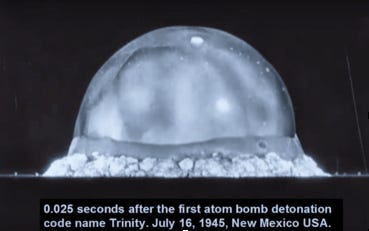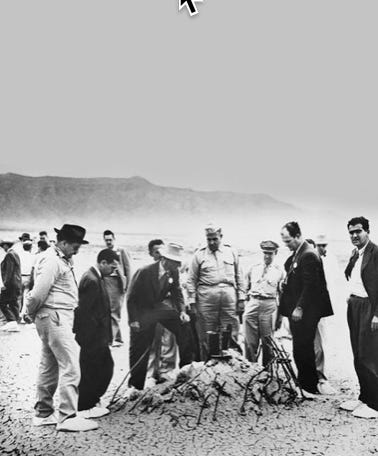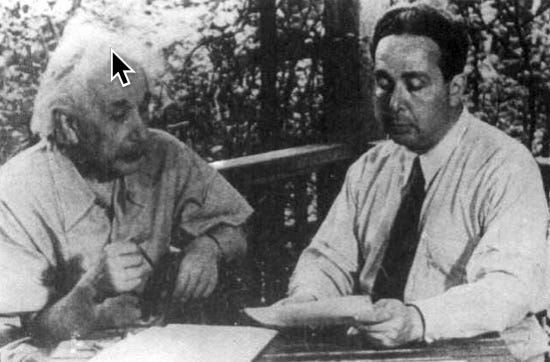Introduction
On the morning of July 16, 1945, just before the sun began to rise over the Jornado del Muerto1 desert basin in New Mexico, the world’s first2 nuclear bomb exploded in a flaming fireball,3 vastly more powerful than any weapon ever created by man. Robert Oppenheimer, the physicist who directed the Manhattan Project, witnessed the event. Overcome with emotion, he uttered these words:
“Now I am become death, the destroyer of worlds.”
The event reminded Oppenheimer of a verse from the Bhagavad Gita4 and the battle-field of Kurukshetra, India, just before a vast slaughter of war was about to begin: Lord Krishna, at the request of his friend and devotee, Arjuna, had driven their war-chariot out between two huge opposing armies in response to Arjuna’s request that he ‘look upon those with whom he would fight.’ In the famous dialogue that followed, Krishna gave one of history's most famous expositions of spiritual life: The Bhagavad Gita. Towards the end of their dialogue, Arjuna asks Krishna to reveal his ‘Universal Form,’ Krishna does so, and the Gita describes what happened:
“If hundreds of thousands of suns were to rise at once into the sky, their radiance might resemble the effulgence of the Lord in that universal appearance . . .” – B.G 11:12
Overwhelmed by the brilliant light, Arjuna cried out to Krishna:
“You are difficult to see because of your glaring effulgence, spreading on all sides, like blazing fire or the immeasurable radiance of the sun.”5 – B.G 11:17
“O Lord of lords, so fierce of form, please tell me who You are. I offer my obeisances unto You; please be gracious to me. You are the primal Lord. I want to understand You, for I do not know what Your purpose is.” – B.G 11:31
Lord Krishna then replied in the words Oppenheimer uttered that fateful day:
“Now I am become death, the destroyer of worlds, and I have come here to destroy all beings.” – B.G 11:32
As the blinding flash of the first atomic bomb lit the early morning sky of the desert, Oppenheimer felt that he, too, was witnessing ‘the all-consuming power of death that lays waste to the world and all beings.’
It was a revelation, a turning point in history, for in that cataclysmic explosion, man entered into a new relationship with life; previously, it was thought only God or nature could wreak such overwhelmingly destructive power, but now mankind had attained that terrible capability as well.
Oppenheimer was not the only one who felt this way; he later said, “. . . all of us did one way or another . . .We knew the world would not be the same. A few people laughed, a few people cried, most people were silent.”6 Every one of the small group who witnessed the explosion of the first atomic bomb realized man’s relationship to life and nature had changed; however, unlike Oppenheimer, most failed to grasp a historical metaphor for such destructive power and did not describe the event so archetypically,7 but not since harnessing the power of fire had there occurred such a massive increase in man’s control over the elements, and it transformed our world forever.
Oppenheimer and General Groves inspect the Trinity bomb site after the test
Einstein and the development of the A-bomb
In 1939, reports came to the attention of the Allies that the Nazis had discovered nuclear fission,8 the antecedent of atomic energy and nuclear weapons. Nazi scientists9 had split the atom and released vast quantums of energy. It was obvious to allied physicists that if the Germans succeeded in controlling this phenomenon, they would use its awesome power to make an atomic bomb and dominate the world, and there were already indications that the Nazis were aware of this possibility.10 Leo Szilard,11 the Jewish Hungarian physicist who first conceived of a nuclear chain reaction, had fled to the United States. Concerned about the consequences of the Nazis developing a bomb, Szilard drafted a letter to President Roosevelt and brought it to Alexander Sachs, banker, Wall Street economist, longtime friend and unofficial advisor to the President. Sachs read the letter and, recognizing its critical importance, told Szilard that someone more prestigious than himself (Szilard) needed to sign the letter so it would make the necessary impression on the president. Sachs suggested that Einstein sign the letter, and then he (Sachs) would deliver it to the president personally; after all, no one was more famous or respected amongst the world's physicists than Albert Einstein. So Szilard brought the letter to Einstein,12 who had moved his family to the United States to escape the Nazis and was living and working at Princeton, New Jersey. So Szilard, along with Edward Teller, brought the letter to Einstein. Szilard and Einstein discussed the issue, and as Szilard made clear the consequences of the Nazis developing an atomic bomb, Einstein is said to have replied, “I did not even think about that.”13
Einstein and Szilard
Einstein’s letter stated:
“In the course of the last four months, it has been made probable — through the work of Joliot in France as well as Fermi and Szilárd in America — that it may become possible to set up a nuclear chain reaction in a large mass of uranium, by which vast amounts of power and large quantities of new radium-like elements would be generated. Now, it appears almost certain that this could be achieved in the immediate future.
This new phenomenon would also lead to the construction of bombs, and it is conceivable — though much less certain — that extremely powerful bombs of a new type may thus be constructed. A single bomb of this type, carried by boat and exploded in a port, might very well destroy the whole port together with some of the surrounding territory . . .” – From the Einstein-Szilard letter14
Einstein signed the letter to Roosevelt, urging that the United States undertake nuclear research that set in motion the development and eventual usage of the atomic bomb.15
Although his theory of relativity (e=mc2) provided key insights and understanding that allowed man to harness the atom, Einstein was a pacifist and wanted no part in developing the terrible capacities for destruction the A-bomb presented. Einstein had previously and publicly declared that if a war broke out, he would “unconditionally refuse to do war service, direct or indirect . . . regardless of how the cause of the war should be judged.” He wrote: “My pacifism is an instinctive feeling, a feeling that possesses me because the murder of men is disgusting. My attitude is not derived from any intellectual theory but is based on my deepest antipathy to every kind of cruelty and hatred.”
However, as Einstein and Szilard16 considered the philosophy, intentions, actions, and atrocities of the Nazis, Einstein was moved to violate his ideal of pacifism and act in favor of creating the atomic bomb. He signed the letter.17
So, how could Einstein approve and encourage the development of the greatest genocidal weapon ever created?18 It was not because he was not a pacifist; he was. It was not because he did not believe in peace and the ideals of the brotherhood of man; he did; it was because of Einstein's fear that the Germans would build the bomb first and destroy the people, cultures, and governments that Hitler hated and he could not let that happen. He expressed his dilemma five months before he died when he wrote, “I made one great mistake in my life . . . when I signed the letter to President Roosevelt recommending that atom bombs be made; but there was some justification – the danger that the Germans would make them (first).”19
As the German army invaded Poland and threatened to overrun the rest of Europe,20 Einstein had grown increasingly afraid for all humanity. He deplored the Nazi belief that they were the ‘purest of the Aryan species’ and the ‘master race of civilization.’ He had experienced Nazi aggression, anti-semitism, and their violent execution of a philosophy that the strong must dominate the weak, and it was fear that caused him to respond in a way that went against his pacifism and ideals.
Fear triggers man’s animal nature, and when men fall under its sway, desired ends are justified by any means.21 Our animal nature drives us to dominate or eliminate our rivals and anyone who seeks to destroy or harm ourselves, those we love, or what we desire and cherish. Who would not be afraid of the Nazis gaining an atomic weapon, especially if they knew its genocidal power? Who would not cry out in awe if they saw and understood the overwhelming implications of the horrific destruction that Oppenheimer recognized in the explosion of the first atomic bomb? Who would not be overwhelmed if they stood with Arjuna on the battlefield of Kurukshetra when God-Krishna revealed his terrible form of all-consuming death and destruction? With the birth of atomic weaponry, man had gained an awesome power of destruction,22 and now nothing was the same; everything had changed . . . except, as Einstein later said, “. . . for the way we think.”23
‘The way we think’ is another way of referring to the way we are, our nature as human beings, what Einstein called - ‘the heart of mankind,’ We in the West call it the ‘Law of the Jungle,’ the Vedic culture calls it Matsya Nyaya or the ‘Law of the Fishes.’
Next week, I will explore the Law of Nature (Matsya Nyaya) and the Nature of Man and how they relate to Oppenheimer and our world today.
Spanish for: “The single days journey of a dead man.”
Oppenheimer was asked, “How do you feel after having exploded the first atomic bomb on earth?” He replied, “This was not the first atomic bomb, but the first atomic bomb in modern times.” According to many scholars, including Oppenheimer, the ancient Indian civilization developed and used weapons with nuclear capabilities. Best known is the Brahmastra,' In Mahabharata, it is explained that when this weapon is invoked, "It blazes up with terrible flames within a huge sphere of fire. Numerous peals of thunder were heard, thousands of meteors fell and all living creatures became terrified with great dread. The entire sky seemed to be filled with noise and assumed a terrible aspect with flames of fire. The whole earth with her mountains and waters and trees trembled." When it strikes an area, it will cause complete destruction, and nothing will ever grow, not even a blade of grass, for the next 12 years. It will not rain for 12 years in that area, and everything, including metal and earth, becomes poisoned."
Many scientists date the beginning of the Anthropocene Age to the moment the atomic bomb exploded. This is when humans began substantially altering the earth’s atmosphere, oceans, surface, and ecological systems.
The Bhagavad Gita (Song of the Lord) is a small part of the Mahabharata and is considered one of the greatest teachings of all time. Oppenheimer studied Sanskrit under Arthur Ryder, the only Sanskrit scholar at Berkeley who could read the Gita in its original form.
Brigadier General Thomas Farrell witnessed the explosion and was bewildered by how “the whole country was lit by a searing light with the intensity many times that of the midday sun. It was golden, purple, violet, gray, and blue. It lighted every peak, crevasse, and ridge of the nearby mountain range with a clarity and beauty that cannot be described but must be seen to be imagined. It was that beauty the great poets dream about but describe most poorly and inadequately.”
"In some sort of crude sense which no vulgarity, no humor, no overstatement can quite extinguish, the physicists have known sin; and this is a knowledge which they cannot lose.” - Robert Oppenheimer.
“The grandeur and magnitude of the phenomena were completely breathtaking.” - Robert Serber. But many did describe what they had seen: “A new thing had just been born; a new control; a new understanding of man, which man had acquired over nature.” - Isidor Rabi, “The grandeur and magnitude of the phenomena were completely breathtaking.” - Robert Serber. “Now we are all sons of bitches,” said Kenneth Bainbridge, Test Director; Oppenheimer later remarked that this was the best thing anyone had said after the test.
In 1938, in Berlin, Otto Hahn and Fritz Strausmann (two German physicists) performed initial tests of bombarding uranium nuclei with the result of producing two other elements as well as an increase of energy that was not expected. The physicist Lisa Meitner understood that this ‘increase of energy’ was explained by Einstein’s e=mc2 and realized that they had actually created nuclear fission. This information gave birth to the further understanding that the splitting of the atom could be weaponized.
Germany had halted the sales of uranium from recently occupied Czechoslovakia and quickly seized heavy water plants in Norway.
Leo Szilard was a 41-year-old physicist who fled the Nazis in the early 1930s for England and discovered the theory of nuclear chain reactions. Szilard moved to the United States in 1938, where he worked with Enrico Fermi and Walter Zinn on means of creating a nuclear chain reaction.
Szilard and Einstein knew each other back in Europe and had worked together before. Szilard and Wigner met Einstein in early July in a cabin in Long Island, NY, where Einstein was on vacation.
“Before the war, scientists often said they thought of physics as almost a spiritual discipline because it seemed to have so little relationship to the practical world of machines and bombs.” - Richard Rhodes, The Making of the Atomic Bomb
“The Einstein–Szilárd letter, signed by Albert Einstein, was sent to President Franklin D. Roosevelt on August 2, 1939. Written by Szilárd in consultation with fellow Hungarian physicists Edward Teller and Eugene Wigner, it warned that Germany might develop atomic bombs and suggested that the United States start its own nuclear program. Roosevelt took immediate action, which, after consulting with several other scientists, eventually resulted in the Manhattan Project developing the first atomic bombs.” – Wikipedia.
Roosevelt replied, thanking Einstein and informing him that: "I found this data of such import that I have convened a Board consisting of the head of the Bureau of Standards and a chosen representative of the Army and Navy to thoroughly investigate the possibilities of your suggestion regarding the element of uranium."
In January 2017, Warren Buffett told students at Columbia University, “If you think about it, we are sitting here, in part, because of two Jewish immigrants who, in August 1939, signed the most important letter in the history of the United States.”
On 6 August 1945, an American B-29 bomber dropped an atomic bomb on the city of Hiroshima. In a split second, 100,000 people ceased to exist. (Hiroshima was chosen as it had no prisoner-of-war camp). Three days later, another B-29 dropped a second bomb on Nagasaki, killing another 40,000.
This ‘justification’ still exists to this day in one form or another and has led to the doctrine of ‘Mutually Assured Destruction’ or MAD. The ‘great mistake’ that Einstein refers to is that he subsequently thought that the bomb was unnecessary . . . both to use against Germany as they had surrendered before it was ready and or against Japanese civilians in the bombing of Hiroshima and Nagasaki as Einstein thought the Japanese were ready to surrender. Einstein later said: “ . . . had I known that the Germans would not succeed in developing an atomic bomb, I would have done nothing.”
On 12 March 1938, the Nazis annexed Austria. Later that year, they marched into the Sudetenland, a part of Czechoslovakia, and on 15 March 1939, the German army invaded the rest of Czechoslovakia. This brought over half a million Jews under German control.
The German invasion of Western Poland on 1 September 1939 led to the start of the Second World War (WW2). Between 1939 and June 1941, the German army invaded and occupied many countries, including the Netherlands, Belgium (Uranium), Luxembourg, France, Denmark (capturing the atomic physicist Niels Bohr), Yugoslavia, Greece, Norway (heavy water plant essential to making an atomic bomb) and Western Poland. By 1940, Nazi Germany possessed all it needed to produce an atomic bomb.
“I did not like the weapon, but I had no qualms if, in the long run, millions of lives could be saved.” - President Truman, who approved the use of the bomb; “There was no question that the bomb must be used . . . we seem suddenly to have become possessed of a merciful abridgement of the slaughter in the east,” - Churchill.
General Eisenhower opposed the use of the bomb. He said, “I hoped that the war might have ended without our having to use the atomic bomb.” It must be added that a group of Japanese military officers planned to have every man, woman, and child fight the United States to the death after Hiroshima; they even attempted a coup to prevent the Emperor surrendering. There are differing opinions about who and what principle was ‘right’ even to this day.
‘With the dawn of the Atomic Age,” says Nobel laureate and University of Toronto chemist John Polanyi, “we were in on something as important as when fire was discovered. The era changed as surely as the Stone Age led to the Bronze Age.”
“The release of atomic power has changed everything except our way of thinking ... the solution to this problem lies in the heart of mankind. If only I had known, I should have become a watchmaker. (1945)” - Albert Einstein






